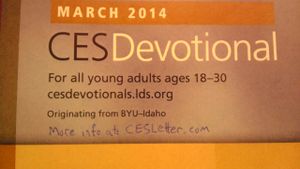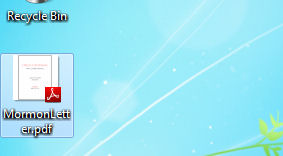
FAIR is a non-profit organization dedicated to providing well-documented answers to criticisms of the doctrine, practice, and history of The Church of Jesus Christ of Latter-day Saints.
I used to think the people at FairMormon were just delusional but with honest intentions. Now after dealing with them for close to a year now? They're not only delusional but dishonest and deceptive.
—Jeremy Runnells, author of "Letter to a CES Director" June 22, 2014. [1]
Googling is not a synonym for seeking.
—Steven C. Harper, Joseph Smith's First Vision: A Guide to the Historical Accounts (2012), 11–12
The "Letter to a CES Director: Why I Lost My Testimony" is an online document which is critical of Latter-day Saint truth claims. The document is comprised of a list of issues that the author states caused him to lose his testimony, and it is hosted on a number of websites which are critical of the Church. [2] The author states that he is "a disaffected member who lost his testimony so it’s no secret which side I’m on at the moment. All this information is a result of over a year of intense research and an absolute rabid obsession with Joseph Smith and Church history. With this said, I’d be pretty arrogant and ignorant to say that I have all the information and that you don’t have answers."
A long list of issues follows. The author ultimately concludes that "There are just way too many problems. We’re not just talking about one issue here. We’re talking about dozens of serious issues that undermine the very foundation of the LDS Church and its truth claims."


Ex-Mormon proponents of what is commonly referred to as the "CES Letter" use a variety of methods to "get the word out" to those whom they wish to deconvert. Fans of the letter scrawl its web address on flyers posted in Church buildings, and leave copies of the letter on public library computers. In April 2014, an anonymous sender and former student emailed the "Letter to a CES Director" to students at the LDS Business College in Salt Lake City. Peggy Fletcher Stack of the Salt Lake Tribune notes:
A spam email with an attachment that discusses concerns with Mormon teachings was sent Tuesday to LDS Business College students. The email was addressed to hundreds enrolled at the church-owned college in downtown Salt Lake City, according to one student who received it. The email — which was not from a school account — listed the sender as LDSBC Important.
The email says, "Dear students, Please read the attached file. It contains important information pertaining to the Church of Jesus Christ of Latter-day Saints. If you have any questions, please feel [sic] to respond. Thank You!"
The attachment is "Letter to a CES Director, Why I Lost My Testimony," by Jeremy Runnells, a sixth-generation Mormon and returned missionary who wrote the piece after experiencing a crisis of faith. The document was published online in April 2013 and updated in February.
("Anti-Mormon spam email targets LDS Business College students," Salt Lake Tribune (Apr 30, 2014)) off-site
Meanwhile, the originator of the email bragged of his accomplishment on the ex-Mormon subreddit:
Hey guys! So I received an email from LDSBC that went out to students (I am a former student) and they forgot to Bcc the recipients. I decided to take advantage of the opportunity to email the CES letter to all the recipients. I wrote a simple email, titles [sic] "Truth Never Lost Grounds to Inquiry" and simply asked in the email for them to read the attached document which had important information pertaining to the LDS church. I didn't send a rant, I didn't attack their beliefs... I just said read it. And then I said respond with questions. Well, we will see where this goes!
(Comment posted to ex-Mormon subreddit in thread "I just emailed 1,000+ LDSBC students the CES letter!" by "livelife2thefullest" on April 30, 2014)
In developing our response, our primary intended audience is not necessarily the author of the Letter nor his associates, but rather those individuals, perhaps faithful Latter-day Saints, perhaps questioning, perhaps once-faithful but now sincerely doubting, who may have come across this Letter and been troubled by its contents. We respond here to the original version of the letter that was actually sent to the CES director and posted on FutureMissionary.com. The author has since made some corrections based upon this analysis and posted an apologetic in defense of his position at http://www.cesletter.com/debunking-fairmormon/
In his Letter to a CES Director, Jeremy Runnells explains how a year of obsessive investigation brought about the loss of his testimony. In an LDS FAQ, LDS blogger Jeff Lindsay deals with all of the same questions, and has done so at least twenty years and has not only an intact testimony, but boundless enthusiasm. What makes the difference? In the parable of the Sower, Jesus explained that the same seeds (words) can generate completely different harvests, ranging from nothing to a hundred-fold increase, all depending on the different soil and nurture. This essay looks at how different expectations and inquiries for translation, prophets, key scriptural passages on representative issues can lead to very different outcomes for investigators.
One of the challenges in defending one’s faith is coping with critics who use the “Big List” technique in their attack. This involves throwing out numerous arguments to create the impression of an overwhelming barrage that decimates the faith in question (see the related post, “If Only 10% of These Charges Are True…“). The Big List is loaded with barbed questions that weren’t written in search of a real answer. If there is a good defense to the arguments raised at first, never mind, there are many more to be launched in different directions.As with many topics in fields like history, science, and religion, the issues raised in Big List attacks are often complex and may require exploring abundant details to answer questions properly. Even for those who are prepared to answer questions on a wide variety of topics, the time it takes to lay a foundation and properly answer a question can be taken by the instantly impatient critics as an admission of weakness and confirmation that they are right, and then it’s time to move on to the next attack and the next. If reasonable answers are promptly provided for some attacks, or if the alleged weakness on further examination actually proves to be evidence in favor of the faithful position, the response can be ignored as new attacks from the Big List are hurled out.
Notes

FAIR is a non-profit organization dedicated to providing well-documented answers to criticisms of the doctrine, practice, and history of The Church of Jesus Christ of Latter-day Saints.
We are a volunteer organization. We invite you to give back.
Donate Now